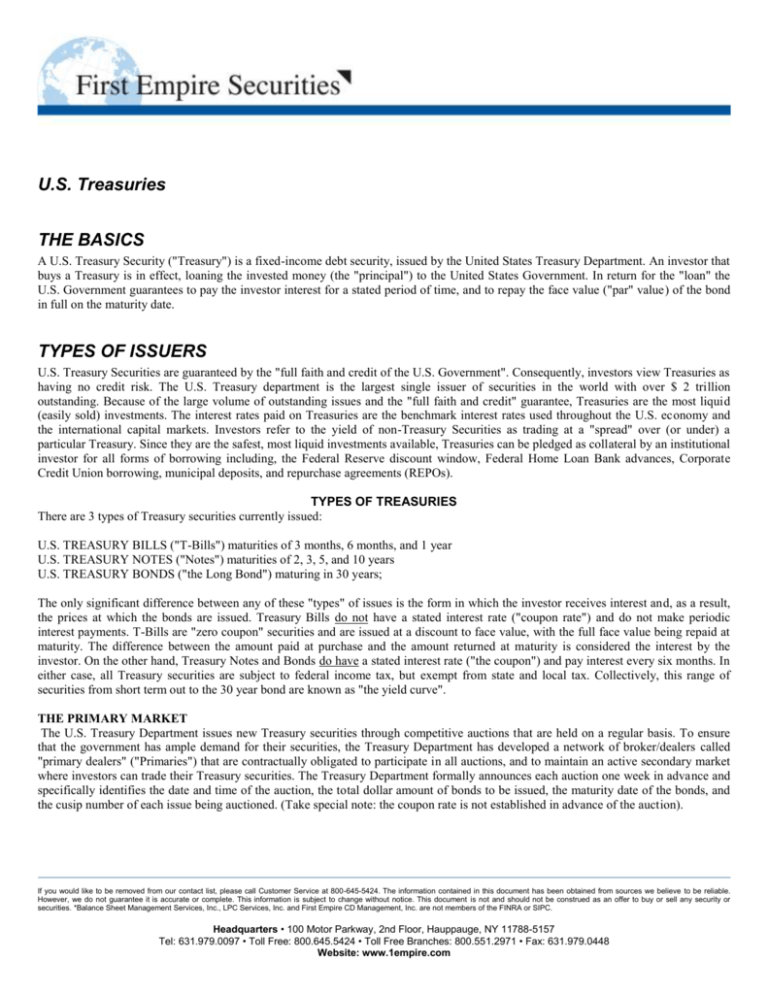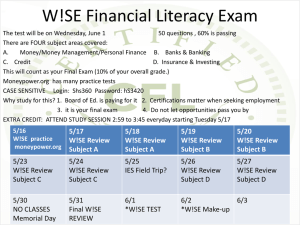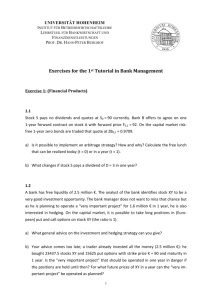us treasury auction cycle
advertisement

U.S. Treasuries THE BASICS A U.S. Treasury Security ("Treasury") is a fixed-income debt security, issued by the United States Treasury Department. An investor that buys a Treasury is in effect, loaning the invested money (the "principal") to the United States Government. In return for the "loan" the U.S. Government guarantees to pay the investor interest for a stated period of time, and to repay the face value ("par" value) of the bond in full on the maturity date. TYPES OF ISSUERS U.S. Treasury Securities are guaranteed by the "full faith and credit of the U.S. Government". Consequently, investors view Treasuries as having no credit risk. The U.S. Treasury department is the largest single issuer of securities in the world with over $ 2 trillion outstanding. Because of the large volume of outstanding issues and the "full faith and credit" guarantee, Treasuries are the most liquid (easily sold) investments. The interest rates paid on Treasuries are the benchmark interest rates used throughout the U.S. economy and the international capital markets. Investors refer to the yield of non-Treasury Securities as trading at a "spread" over (or under) a particular Treasury. Since they are the safest, most liquid investments available, Treasuries can be pledged as collateral by an institutional investor for all forms of borrowing including, the Federal Reserve discount window, Federal Home Loan Bank advances, Corporate Credit Union borrowing, municipal deposits, and repurchase agreements (REPOs). TYPES OF TREASURIES There are 3 types of Treasury securities currently issued: U.S. TREASURY BILLS ("T-Bills") maturities of 3 months, 6 months, and 1 year U.S. TREASURY NOTES ("Notes") maturities of 2, 3, 5, and 10 years U.S. TREASURY BONDS ("the Long Bond") maturing in 30 years; The only significant difference between any of these "types" of issues is the form in which the investor receives interest and, as a result, the prices at which the bonds are issued. Treasury Bills do not have a stated interest rate ("coupon rate") and do not make periodic interest payments. T-Bills are "zero coupon" securities and are issued at a discount to face value, with the full face value being repaid at maturity. The difference between the amount paid at purchase and the amount returned at maturity is considered the interest by the investor. On the other hand, Treasury Notes and Bonds do have a stated interest rate ("the coupon") and pay interest every six months. In either case, all Treasury securities are subject to federal income tax, but exempt from state and local tax. Collectively, this range of securities from short term out to the 30 year bond are known as "the yield curve". THE PRIMARY MARKET The U.S. Treasury Department issues new Treasury securities through competitive auctions that are held on a regular basis. To ensure that the government has ample demand for their securities, the Treasury Department has developed a network of broker/dealers called "primary dealers" ("Primaries") that are contractually obligated to participate in all auctions, and to maintain an active secondary market where investors can trade their Treasury securities. The Treasury Department formally announces each auction one week in advance and specifically identifies the date and time of the auction, the total dollar amount of bonds to be issued, the maturity date of the bonds, and the cusip number of each issue being auctioned. (Take special note: the coupon rate is not established in advance of the auction). If you would like to be removed from our contact list, please call Customer Service at 800-645-5424. The information contained in this document has been obtained from sources we believe to be reliable. However, we do not guarantee it is accurate or complete. This information is subject to change without notice. This document is not and should not be construed as an offer to buy or sell any security or securities. *Balance Sheet Management Services, Inc., LPC Services, Inc. and First Empire CD Management, Inc. are not members of the FINRA or SIPC. Headquarters • 100 Motor Parkway, 2nd Floor, Hauppauge, NY 11788-5157 Tel: 631.979.0097 • Toll Free: 800.645.5424 • Toll Free Branches: 800.551.2971 • Fax: 631.979.0448 Website: www.1empire.com U.S. TREASURY AUCTION CYCLE Issue Frequency Schedule Months 3, 6, 12 Month Bills Weekly Every Monday N/A 2 Year Monthly Last Wednesday Every Month 5 & 10 Year Notes Quarterly Tuesday & Wednesday of the 2nd Week Feb, May, Aug, Nov 30 Year Bond Semi-Annually Thursday of the 2nd Week Feb, Aug After the announcement, the Primaries immediately start taking commitments from investors to purchase the new securities when they are issued. This trading of Treasuries in advance of their auction is called the "when issued" market ("W.I."). W.I. Treasuries are bought and sold on a yield basis (since the coupon rate is unknown, brokers don't know exactly what price equates to what yield until after the coupon is set following the auction). The auction itself takes place at the Federal Reserve Bank of New York, where each Primary submits its offer (eg: total amount of bonds wanted and what yield they will pay). In addition the Treasury Department collects "non-competitive" offers from small investors who agree to accept their bonds at the average price and yield tendered by the primaries. The Treasury Department then tabulates all offers, allocates bonds to the non-competitive offers, and then awards the balance to the Primaries at the lowest interest rate (cheapest cost to the government) possible. Finally, once all the orders to be filled have been calculated, the Treasury department will set the coupon rate based upon the average interest rate of the accepted offers. Then the Primaries can calculate the price they must pay for their allocation of bonds, and in turn calculate the price for all of the WI trades they executed. Because of the large demand for bonds, the highest yield (lowest price) orders tendered at the auction are not filled. These dealers must then go out and buy bonds in the secondary market (from the "winners" at the auction) so they can fill the commitment they made in the "when issued" market. THE SECONDARY MARKET After issuance and prior to maturity, a bond can be bought and/or sold ("traded") by its owner to another investor. Bonds are bought and sold in this "secondary market" at a price negotiated between the buyer and seller. The price is quoted as a percentage of face value and referred to as being at a premium, at par, or at a discount. For instance, if the price is "par" the bond would be selling at 100.00% of face value. A "discount" price might be 99.00% (verbally quoted as "ninety-nine"), and a "premium" price might be 101.00% (quoted as "oneoh-one"). PRICE The price paid for a bond is based upon the general level of interest rates at the time of purchase. When a security is issued, the coupon rate will be reflective of the current interest rate environment, and the price will typically be at or close to par (100.00% of face value). After the bond is issued, if interest rates go down, the price of the bond will go up (to more than 100.00% of face value). This happens because a new bond issued in the lower interest rate environment would have a lower coupon rate, and trade at or close to par. The investor selling the older bond (with a higher coupon rate) would demand a higher price (a "premium") for the bond (it has a higher coupon, pays more interest and, therefore is more valuable). Conversely, after a bond is issued, if interest rates go up, the price for the security will decline (to a "discount") because its coupon will be less valuable. Of course, no investor is obligated to sell a bond prior to maturity regardless of whether interest rates rise or fall. YIELD The price paid by the buyer will equate to an "effective yield" to the bond's stated maturity. The effective yield to maturity is calculated using a mathematical combination of the price paid, the coupon interest rate and the remaining term to maturity. If you would like to be removed from our contact list, please call Customer Service at 800-645-5424. The information contained in this document has been obtained from sources we believe to be reliable. However, we do not guarantee it is accurate or complete. This information is subject to change without notice. This document is not and should not be construed as an offer to buy or sell any security or securities. *Balance Sheet Management Services, Inc., LPC Services, Inc. and First Empire CD Management, Inc. are not members of the FINRA or SIPC. Headquarters • 100 Motor Parkway, 2nd Floor, Hauppauge, NY 11788-5157 Tel: 631.979.0097 • Toll Free: 800.645.5424 • Toll Free Branches: 800.551.2971 • Fax: 631.979.0448 Website: www.1empire.com At purchase the investor will pay $ 1,100,000.00 to buy the bond ($ 1 million par value TIMES 110.00% price). This time the investor has paid an effective annual PREMIUM of $10,000 ($ 100,000 premium paid DIVIDED by ten years to maturity). The investor will receive the same semi-annual interest payments of $ 50,000 (the 10% coupon rate TIMES the $ 1 million par value DIVIDED by 2), and only the par value of $ 1 million at maturity. When you subtract the effective annual premium (- $ 10,000) from the annual interest payments ($ 100,000), this gives the investor a net effective annual yield of 9% ($ 90,000 total annual income DIVIDED by $ 1 million par = 9%). SETTLEMENT Treasury securities are issued in book-entry form (there is no physical certificate) and are maintained and delivered on the Federal Reserve wire system. The delivery of a bond by the seller, and payment for the bond by the buyer is referred to as "settlement". U.S. Treasury securities trading in the secondary market settle the next business day after the "trade date" (the deal is negotiated today and consummated tomorrow). In the "when issued" market settlement is usually about one week after the auction. Regardless of when settlement occurs, once the terms of the sale are agreed upon by both parties (on the trade date), the price, yield, dollar amount due, and settlement date will not change. ACCRUED INTEREST Treasuries pay semi-annual interest at the coupon rate on a set schedule from issuance through maturity. When a bond is sold in the secondary market it is uncommon for the settlement to take place exactly on an interest payment date (there are only 2 interest payments per year). At settlement, the buyer pays the seller the purchase price PLUS interest earned ("accrued") by the seller from the last interest payment, up to, but not including the settlement date. This is referred to as the "accrued interest". The mathematical formula to calculate the accrued interest due is: Par Value TIMES Coupon Rate DIVIDED by 365 TIMES # Days from the last interest payment = Accrued Interest The accrued interest paid at settlement will be "refunded" to the buyer as part of the interest payment on the next interest pay date. To use our above example, on July 1, the buyer will receive a full 6 months ($ 50,000) of interest. This is the 3 months accrued interest ($25,000) originally paid out at settlement and 3 months earned income ($25,000) for the time the investor owned the bond (April 1 thru July 1). CONCLUSION U.S. Treasury securities are debt securities issued by the U.S. Government. The Government will pay the investor interest for a stated period of time, and repay the principal at face value on the maturity date. U.S. Treasury securities are the safest securities in the world because they are backed by "the full faith and credit" of the U.S. Government. In addition, because of the large volume of bonds outstanding, Treasuries are also the most liquid securities and can be traded at a price and yield comparable to the general level of interest rates at that time. As with all debt instruments, the sale prior to maturity may cause a capital gain or loss. If you would like to be removed from our contact list, please call Customer Service at 800-645-5424. The information contained in this document has been obtained from sources we believe to be reliable. However, we do not guarantee it is accurate or complete. This information is subject to change without notice. This document is not and should not be construed as an offer to buy or sell any security or securities. *Balance Sheet Management Services, Inc., LPC Services, Inc. and First Empire CD Management, Inc. are not members of the FINRA or SIPC. Headquarters • 100 Motor Parkway, 2nd Floor, Hauppauge, NY 11788-5157 Tel: 631.979.0097 • Toll Free: 800.645.5424 • Toll Free Branches: 800.551.2971 • Fax: 631.979.0448 Website: www.1empire.com








